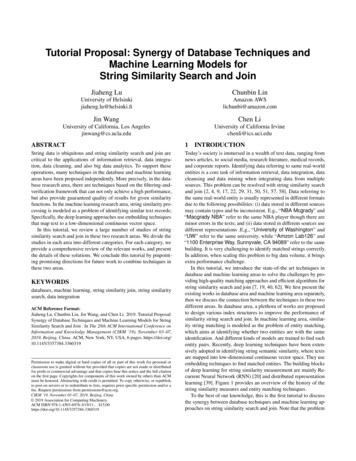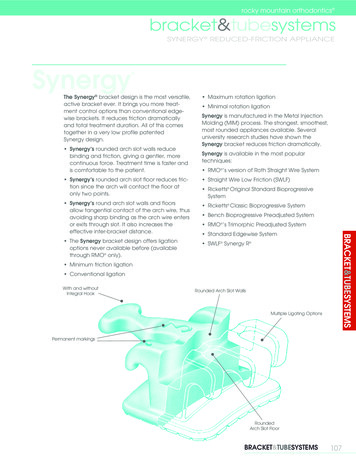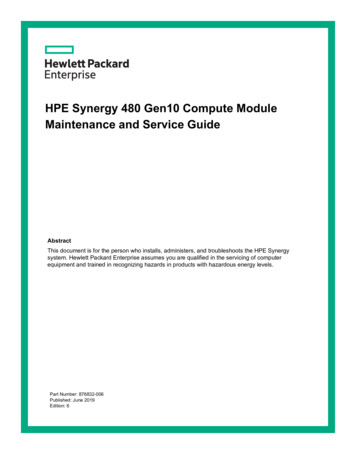
Transcription
Tutorial Proposal: Synergy of Database Techniques andMachine Learning Models forString Similarity Search and JoinJiaheng LuChunbin LinUniversity of Helsinkijiaheng.lu@helsinki.fiAmazon AWSlichunbi@amazon.comJin WangChen LiUniversity of California, Los Angelesjinwang@cs.ucla.eduUniversity of California Irvinechenli@ics.uci.eduABSTRACT1String data is ubiquitous and string similarity search and join arecritical to the applications of information retrieval, data integration, data cleaning, and also big data analytics. To support theseoperations, many techniques in the database and machine learningareas have been proposed independently. More precisely, in the database research area, there are techniques based on the filtering-andverification framework that can not only achieve a high performance,but also provide guaranteed quality of results for given similarityfunctions. In the machine learning research area, string similarity processing is modeled as a problem of identifying similar text records;Specifically, the deep learning approaches use embedding techniquesthat map text to a low-dimensional continuous vector space.In this tutorial, we review a large number of studies of stringsimilarity search and join in these two research areas. We divide thestudies in each area into different categories. For each category, weprovide a comprehensive review of the relevant works, and presentthe details of these solutions. We conclude this tutorial by pinpointing promising directions for future work to combine techniques inthese two areas.Today’s society is immersed in a wealth of text data, ranging fromnews articles, to social media, research literature, medical records,and corporate reports. Identifying data referring to same real-worldentities is a core task of information retrieval, data integration, datacleansing and data mining when integrating data from multiplesources. This problem can be resolved with string similarity searchand join [2, 4, 9, 17, 22, 29, 31, 50, 51, 57, 58]. Data referring tothe same real-world entity is usually represented in different formatsdue to the following possibilities: (i) data stored in different sourcesmay contain typos and be inconsistent. E.g., “NBA Mcgrady” and“Macgrady NBA” refer to the same NBA player though there areminor errors in the texts; and (ii) data stored in different sources usedifferent representations .E.g., “University of Washington” and“UW” refer to the same university, while “Amzon Lab126” and“1100 Enterprise Way, Sunnyvale, CA 94089” refer to the samebuilding. It is very challenging to identify matched strings correctly.In addition, when scaling this problem to big data volume, it bringsextra performance challenge.In this tutorial, we introduce the state-of-the art techniques indatabase and machine learning areas to solve the challenges by providing high-quality matching approaches and efficient algorithms forstring similarity search and join [7, 19, 40, 62]. We first present theexisting works in database area and machine learning area separately,then we discuss the connection between the techniques in these twodifferent areas. In database area, a plethora of works are proposedto design various index structures to improve the performance ofsimilarity string search and join. In machine learning area, similarity string matching is modeled as the problem of entity matching,which aims at identifying whether two entities are with the sameidentification. And different kinds of models are trained to find suchentity pairs. Recently, deep learning techniques have been extensively adopted in identifying string semantic similarity, where textsare mapped into low-dimensional continuous vector space. They useembedding techniques to find matched entities. The building blocksof deep learning for string similarity measurement are mainly Recurrent Neural Network (RNN) [20] and distributed representationlearning [39]. Figure 1 provides an overview of the history of thestring similarity measures and entity matching techniques.To the best of our knowledge, this is the first tutorial to discussthe synergy between database techniques and machine learning approaches on string similarity search and join. Note that the problemKEYWORDSdatabases, machine learning, string similarity join, string similaritysearch, data integrationACM Reference Format:Jiaheng Lu, Chunbin Lin, Jin Wang, and Chen Li. 2019. Tutorial Proposal:Synergy of Database Techniques and Machine Learning Models for StringSimilarity Search and Join . In The 28th ACM International Conference onInformation and Knowledge Management (CIKM ’19), November 03–07,2019, Beijing, China. ACM, New York, NY, USA, 6 pages. https://doi.org/10.1145/3357384.3360319Permission to make digital or hard copies of all or part of this work for personal orclassroom use is granted without fee provided that copies are not made or distributedfor profit or commercial advantage and that copies bear this notice and the full citationon the first page. Copyrights for components of this work owned by others than ACMmust be honored. Abstracting with credit is permitted. To copy otherwise, or republish,to post on servers or to redistribute to lists, requires prior specific permission and/or afee. Request permissions from permissions@acm.org.CIKM ’19, November 03–07, 2019, Beijing, China 2019 Association for Computing Machinery.ACM ISBN 978-1-4503-6976-3/19/11. . . UCTION
CIKM ’19, November 03–07, 2019, Beijing, ChinaLu et al.Figure 1: Recent 20 years of string similarity measuresof string similarity matching was well studied in computer science.The first references to this problem could be traced to the sixtiesand seventies [41], where the problem appeared in a number of different fields, such as computational biology, signal processing, andtext retrieval. However, this tutorial will review this problem froma novel angle through the synergy between database and machinelearning techniques. The existing tutorial and survey review thisproblem separately from their respective fields. We have identifiedfew tutorials (e.g. [24]) on string similarity search, which are mainlyfrom VLDB and ICDE. However, they were given in 2009, ten yearsago. This tutorial, on the other hand, focuses on the state-of-the-artworks on string similarity search and join bridging the two fields ofdatabase and machine learning.Relevance to CIKM The topic of the tutorial is closely related toCIKM. The 2019 theme “AI for the future life” emphasizes the targetof AI with all their features. This tutorial will combine the techniqueof databases and machine learning for string similarity processing.Efficient search and join of string data is a fundamental problemfor various fields covered by CIKM conference, e.g., informationretrievals, data management and data mining. In this tutorial, we willshow the approaches and features that the current string processingframeworks offer, as well as their limitations and open challengingresearch areas.2 COVERED TOPICS2.1 Background and preliminariesString is ubiquitous in computer science. In the first part of the tutorial, we will provide several motivating examples of string similaritysearch and join, followed by a brief introduction on their wide applications in various fields, such as information retrieval, databasesand data mining, to name a few.2.2Database techniquesTo identify similarity strings, most existing studies utilize eithercharacter-based similarity functions, e.g., edit distance and hammingdistance, or token-based similarity functions, e.g. Overlap, Jaccardand Cosine, to quantify similarity of two strings. There are alsosimilarity functions to combine character-based and token-basedsimilarity functions together (e.g. [49, 53]).2.2.1 String Similarity Search. String similarity search findsall strings that are similar to a given query from a defined stringdataset. There are two variants of similarity search problem: thresholdbased and top-k search. Similarity search needs to construct theindex in an offline step without knowing the similarity thresholdsahead of time. Existing studies proposed a series of indexing techniques to improve the search performance, such as inverted list basedindexes [5, 26, 32] and tree based ones [35, 48, 61, 65–67].2.2.2 String Similarity Join. String similarity join is a fundamental operation in many applications, such as data cleaning andintegration. Given two collections of strings, string similarity joinaims at finding all similar string pairs from the two collections. Mostexisting studies adopt the filter-and-verification framework to improve the performance of string similarity join. In the filtering step,signatures are generated for each string and used to identify candidate pairs. In the verification step, the real similarity is calculated onthe candidate pairs to generate the final results. To improve the pruning powers, a variety of filtering techniques are proposed, such ascount filter [22], prefix filter [4, 9, 50], position filter [58], mismatchfilter [57] and segment filter [17, 31].Recently there is an increasing demand for more efficient approaches which can scale up to increasingly vast volume of dataas well as make good use of rich computing resources. Similar toprevious centralized algorithms, such distributed algorithms focusedon finding high quality signatures to improve the overall performance. Meanwhile, distributed algorithms also need to address theproblem of data skew so as to ensure load balance between allworkers in a cluster. To support string similarity joins over big data,many recent contributions focus on implementing algorithms onMap-Reduce [21]. Vernica et al. [47] adopted the prefix filter inthe MapReduce framework to enhance the filter power of parallelsimilarity join. A large body of studies followed its way to makeoptimization in computing similarity score [37], estimating cost [1],improving the signatures [16] and addressing data skewness [44].Recently a systems-oriented approach [27] is proposed to efficientlysupport the similarity search and join operations upon the ApacheAsterixDB system.2.2.3 Approximate Entity Extraction. Dictionary based Approximate Entity Extraction(AEE) is a typical application scenario ofthe string similarity join techniques.Given a predefined dictionary ofentities, a similarity threshold and a collection of documents, it aimsat identifying all substrings from a document that are similar withentities in the dictionary by employing syntactic similarity functions(e.g. Jaccard and Edit Distance).To accelerate this process, previousstudies utilized different approaches, such as hashing [8], neighborhood generation [56] and segmentation indexing [14].Faerie [15] isan all-purposed framework to support multiple kinds of similarity
Tutorial ProposalCIKM ’19, November 03–07, 2019, Beijing, Chinametrics in AEE problem.Wang et al. [55] addressed the local similarity search problem, which is a variant of AEE problem but withmore limitations.and introduced a unified template of deep learning methods for entity matching by considering 3 crucial steps: attribute embedding,attribute similarity and classifier.2.2.4 Synonym-based Semantic Similarity. Though abovestudies have achieved significant degree of success in identifying thesyntactic similar strings, they would still miss some results that aresemantically similar with each other. To this end, Arasu et al. [3] integrated synonym rules with syntactic similar metrics to improve thequality of string matching. Lu et al. [33, 34] followed this route andproposed efficient string join algorithms with synonyms. RecentlyWang et al. [52] introduced synonym rules into the approximate entity extraction problem to combine the synonym rules with syntacticsimilarity metrics. Xu et al. [59, 60] study how to use taxonomyknowledge to enable semantic similarity joins.2.42.3Machine leaning techniques2.3.1 Traditional Machine Learning based Approaches.Machine Learning techniques have been prove to be effective in thetask of Entity Matching (a.k.a Entity Resolution), which is an important application that relies on string similarity measurement. It aimsat identifying data instances that refer to the same real world entity.Traditional approaches modeled entity matching as a supervisedlearning problem. MARLIN [6] utilized Support Vector Machineto capture the syntactic features and attributes, while [18] reliedon Bayesian network. The Magellan system [29] provided an endto-end solution based on a variety of similarity measurements. Itsupported entity matching with both machine learning and rule basesmethods. The Falcon system [13] further integrated human laborinto this process to improve the effectiveness and provide a systemdeployment on top of Apache Hadoop.2.3.2 Deep Learning Approaches. Nowadays deep learningtechniques have been extensively adopted in identifying string semantic similarity. The building blocks of deep learning for string similarity measurement are mainly Recurrent Neural Network (RNN) [20]and distributed representation learning [39]. RNN is a family of neural networks with a dynamic temporal behavior. A neuron in RNN isfed information not only from the previous time step, but also fromits own previous state in time, to process sequences of inputs. Distributed representation learning maps texts into a low-dimensionalcontinuous vector space to learn the embedding of them. There area series of studies in this category, ranging from the embedding ofword [38, 39, 43], phrase [10, 25, 45], sentence [12, 28, 30, 42] todocument level [36, 46, 54, 64]. Compared with traditional rulebased methods, these embedding approaches can make better useof the large training data and achieve superior performance. Traditional Natural Language Processing tasks that related to semanticsimilarity can also benefit from the techniques of distributed wordrepresentation and deep neural networks. Typical examples includenatural language inference [11], semantic matching [23] and relationextraction [63].Recently there are several studies that utilized deep learning techniques for string similarity matching. DeepER [19] aimed at learningthe latent representation of entities to enable more accurate matching.It can be applied in cases whether the pre-trained word embeddingis available or not. Mudgal et al. [40] extended the work of DeepERThe Integration of Database and MachineLearning TechniquesIn above sections, we introduce the recent studies in both databaseand machine learning fields. On the one hand, the studies in thedatabase field can provide high efficiency and good interpretability.However, they mainly rely on syntactic features and simple semantic resources like synonym rules, which result in limited power ofeffectiveness. On the other hand, the machine learning based workscan automatically learn from massive corpus and capture extensivesemantics. But they require tedious training time and human annotated dataset, which is rather expensive. An emerging trend isto combine database techniques with those in the field of machinelearning to take advantage of both of them. Recently Smurf [7] isthe up-to-date work which combines machine learning and databasetechniques to enable automatic matching between two string sets.It can first automatically acquire the features by considering predefined rules as well as syntactic similarity. Then it adopts the randomforest model to learn the features for matching similar strings. Itfurther adopts multiple techniques from database community, suchas indexing, query planning and pruning, to improve the efficiencyof the learnign process.2.5Future challengeOptimize the pipeline of String Similarity Queries As shownabove, there have been many studies about string similarity searchand join in the database community. However, they just focus on thealgorithm level optimization. To make the similarity search and jointechniques more usable in practical applications, it further calls foran end-to-end pipeline to deal with the whole life cycle of the task.It is essential to build such a pipeline on relational database management systems like MySQL or NoSQL database like MongoDB.More Efficient ML based Approaches The up-to-date approachesadopt deep learning techniques, i.e. word embedding and variantsof RNN models, on the task of entity matching and achieve state-ofthe-art performance. Though the promising results in the aspect ofeffectiveness, there are still remaining problems on efficiency. Compared with the rule-based approaches as well as the string similaritysearch and join approaches, the machine learning based methodsneed a relatively long time for training the model. Moreover, sincethe dominant approaches in this category are supervised ones, itrequires a large amount of labeled data to serve as the training set,which is rather expensive due to human labor for annotation. How toautomatically acquire training data or develop efficient unsupervisedapproaches for the problem of entity matching remain to be an openproblem.Combine Human-in-the-Loop Approaches with ML As is wellknown, some important data analytic tasks cannot be completelyaddressed by automated processes. It is essential to involve humancognitive ability into this process to enhance the overall performance.Recently the crowdsourcing approaches have been widely adopted indifferent tasks related to string similarity measurement. They serveas a crucial signal in recognizing the truth. The future direction is to
CIKM ’19, November 03–07, 2019, Beijing, Chinaautomatically identify when and to what extent should human laborbe involved in the process with effective machine learning tools. TheFalcon system [13] is the first work towards this goal and there isfurther room to improve.3Lu et al.4.1The history and motivation for string similarity searches andjoins. The categorization and methods of string similarity searchesand joins in database area, including various filtering strategies, distributed algorithms, synonym and taxonomy basedalgorithms; The methodology and models of string similarity searches andjoins in machine learning area, including traditional machinelearning based approaches and deep learning approaches. The synergy of database and machine learning techniques toenable automatic string similarity processing.TUTORIAL ORGANIZATIONThis tutorial consists of 4 parts and is planned for 3 hours. Thedetails are explained as following.Motivation and Background (30 minutes). A brief overview of the history of string similarity search andjoin. The real world applications of string similarity search and join. The formal problem definition and necessary background.Database Related Techniques (60 Minutes). State-of-the-art algorithms about String similarity join. String similarity search algorithms. Enhancing string similarity and join with semantic featuresincluding synonym and taxonomy knowledge Application of string search and join techniques, including approximate entity extraction, query auto-complete and conjunction with other kinds of data, e.g. graph, spatial and streaming.Machine Learning Related Techniques (60 Minutes). Traditional machine learning approaches for string similaritymeasurement. Preliminary about deep learning and its application in naturallanguage processing. String similarity measurement with deep learning techniques.Synergy between Database and Machine Learning (15 Minutes). Applying database filtering technique to enhance machine leaning algorithms.Incorporating machine leaning models in string similarity functions for string joins in databases.Open Problems (15 Minutes). General purposed pipeline for string similarity search and join. Accelerating the machine learning based approaches. Combining Human-in-the-loop with machine learning approachesfor better performance.4GOALS OF THE TUTORIALString similarity search and join are very generic problems in bothdatabase and machine learning areas. Though each individual areahas many promising techniques proposed to solve the problems, theyare considered as orthogonal approaches. This tutorial will think thisproblem in a higher level of view by combining techniques in bothdatabase and machine learning areas. In the following, we presentthe main learning outcomes of this tutorial in two aspects: (i) thetake-away items from the existing work; and (ii) the challenge anddirections to motivate future researches.Take-away items. 4.2Future directions of the synergy. From database to machine learning. Existing work in database area focus more on improving the performance by applying fast filtering techniques, which can be modified andutilized in machine learning algorithms. One example is touse such database techniques to fast filter dirty training data. From machine learning to database. Existing work in machine learning improves the matching quality by consideringthe semantics, which can be applied in database algorithmsto enhance the similarity measure functions.4.3Intended AudienceThis tutorial is intended for a wide scope of audience ranging fromacademic researchers to industrial data scientists that want to understand the string similarity processing algorithms in the era of big dataand AI. Basic knowledge in string processing in databases is sufficient to follow the tutorial. Some background in machine learningand deep learning techniques would be useful but not necessary.5SHORT BIBLIOGRAPHIES OF TUTORSJiaheng Lu is an Associate Professor at the University of Helsinki,Finland. His main research interests lie in the big data managementand database systems, and specifically in the challenge of efficientdata processing from real-life, massive data repository and Web.He has written four books on Hadoop and NoSQL databases, andmore than 80 journal and conference papers published in SIGMOD,VLDB, TODS, and TKDE, etc. He will attend CIKM and presentpart of the tutorial.Chunbin Lin is a database engineer at Amazon Web Services(AWS) and he is working on AWS Redshift. He completed hisPh.D. in computer science at the University of California, San Diego(UCSD). His research interests are database management and bigdata management. He has more than 20 journal and conferencepapers published in SIGMOD, VLDB, VLDB J, and TODS, etc. Hewill attend CIKM and present part of the tutorial.Jin Wang is a fourth year PhD student at the University of California, Los Angeles. Before joining UCLA, he obtained his masterdegree in computer science from Tsinghua University in the year2015. His research interest mainly lies in the field of data management and text analytics. He has published more than 10 papers intop-tier conferences and journals like ICDE, IJCAI, EDBT, TKDE
Tutorial Proposaland VLDB Journal. He will attend CIKM and present part of thetutorial.Chen Li is a professor in the Department of Computer Science atUC Irvine. He received his Ph.D. degree in Computer Science fromStanford University. His research interests are in the field of datamanagement, including data-intensive computing, query processingand optimization, visualization, and text analytics. He will helpprepare the tutorial material. Due to his teaching workload in UCI,he probably will not attend CIKM conference.REFERENCES[1] F. N. Afrati, A. D. Sarma, D. Menestrina, A. G. Parameswaran, and J. D. Ullman.Fuzzy joins using mapreduce. In ICDE, pages 498–509, 2012.[2] P. Agrawal, A. Arasu, and R. Kaushik. On indexing error-tolerant set containment.In SIGMOD, pages 927–938, 2010.[3] A. Arasu, S. Chaudhuri, and R. Kaushik. Transformation-based framework forrecord matching. In ICDE, pages 40–49, 2008.[4] R. J. Bayardo, Y. Ma, and R. Srikant. Scaling up all pairs similarity search. InWWW, pages 131–140, 2007.[5] A. Behm, C. Li, and M. J. Carey. Answering approximate string queries on largedata sets using external memory. In ICDE, pages 888–899, 2011.[6] M. Bilenko and R. J. Mooney. Adaptive duplicate detection using learnable stringsimilarity measures. In ACM SIGKDD, pages 39–48, 2003.[7] P. S. G. C., A. Ardalan, A. Doan, and A. Akella. Smurf: Self-service stringmatching using random forests. PVLDB, 12(3):278–291, 2018.[8] K. Chakrabarti, S. Chaudhuri, V. Ganti, and D. Xin. An efficient filter for approximate membership checking. In SIGMOD, pages 805–818, 2008.[9] S. Chaudhuri, V. Ganti, and R. Kaushik. A primitive operator for similarity joinsin data cleaning. In ICDE, page 5, 2006.[10] K. Cho, B. van Merrienboer, Ç. Gülçehre, D. Bahdanau, F. Bougares, H. Schwenk,and Y. Bengio. Learning phrase representations using RNN encoder-decoder forstatistical machine translation. In EMNLP, pages 1724–1734, 2014.[11] A. Conneau, D. Kiela, H. Schwenk, L. Barrault, and A. Bordes. Supervisedlearning of universal sentence representations from natural language inferencedata. In EMNLP, pages 670–680, 2017.[12] A. Conneau, G. Kruszewski, G. Lample, L. Barrault, and M. Baroni. What youcan cram into a single \ &!#* vector: Probing sentence embeddings for linguisticproperties. In ACL, pages 2126–2136, 2018.[13] S. Das, P. S. G. C., A. Doan, J. F. Naughton, G. Krishnan, R. Deep, E. Arcaute,V. Raghavendra, and Y. Park. Falcon: Scaling up hands-off crowdsourced entitymatching to build cloud services. In SIGMOD, pages 1431–1446, 2017.[14] D. Deng, G. Li, and J. Feng. An efficient trie-based method for approximate entityextraction with edit-distance constraints. In ICDE, pages 762–773, 2012.[15] D. Deng, G. Li, J. Feng, Y. Duan, and Z. Gong. A unified framework for approximate dictionary-based entity extraction. VLDB J., 24(1):143–167, 2015.[16] D. Deng, G. Li, S. Hao, J. Wang, and J. Feng. Massjoin: A mapreduce-basedmethod for scalable string similarity joins. In ICDE, pages 340–351, 2014.[17] D. Deng, G. Li, H. Wen, and J. Feng. An efficient partition based method for exactset similarity joins. PVLDB, 9(4):360–371, 2015.[18] X. Dong, A. Y. Halevy, and J. Madhavan. Reference reconciliation in complexinformation spaces. In SIGMOD, pages 85–96, 2005.[19] M. Ebraheem, S. Thirumuruganathan, S. R. Joty, M. Ouzzani, and N. Tang. Distributed representations of tuples for entity resolution. PVLDB, 11(11):1454–1467,2018.[20] J. L. Elman. Finding structure in time. Cognitive Science, 14(2):179–211, 1990.[21] F. Fier, N. Augsten, P. Bouros, U. Leser, and J.-C. Freytag. Set similarity joins onmapreduce: An experimental survey. PVLDB, 11(10):1110–1122, 2018.[22] L. Gravano, P. G. Ipeirotis, H. V. Jagadish, N. Koudas, S. Muthukrishnan, andD. Srivastava. Approximate string joins in a database (almost) for free. In VLDB,pages 491–500, 2001.[23] J. Guo, Y. Fan, Q. Ai, and W. B. Croft. Semantic matching by non-linear wordtransportation for information retrieval. In CIKM, pages 701–710, 2016.[24] M. Hadjieleftheriou and C. Li. Efficient approximate search on string collections.PVLDB, 2(2):1660–1661, 2009.[25] F. Hill, K. Cho, A. Korhonen, and Y. Bengio. Learning to understand phrases byembedding the dictionary. TACL, 4:17–30, 2016.[26] J. Kim, C. Li, and X. Xie. Hobbes3: Dynamic generation of variable-lengthsignatures for efficient approximate subsequence mappings. In ICDE, pages169–180, 2016.[27] T. Kim, W. Li, A. Behm, I. Cetindil, R. Vernica, V. R. Borkar, M. J. Carey, andC. Li. Supporting similarity queries in apache asterixdb. In EDBT, pages 528–539,2018.[28] Y. Kim. Convolutional neural networks for sentence classification. In EMNLP,pages 1746–1751, 2014.CIKM ’19, November 03–07, 2019, Beijing, China[29] P. Konda, S. Das, P. S. G. C., A. Doan, A. Ardalan, J. R. Ballard, H. Li, F. Panahi,H. Zhang, J. F. Naughton, S. Prasad, G. Krishnan, R. Deep, and V. Raghavendra. Magellan: Toward building entity matching management systems. PVLDB,9(12):1197–1208, 2016.[30] Q. V. Le and T. Mikolov. Distributed representations of sentences and documents.In ICML, pages 1188–1196, 2014.[31] G. Li, D. Deng, J. Wang, and J. Feng. PASS-JOIN: A partition-based method forsimilarity joins. PVLDB, 5(3):253–264, 2011.[32] W. Li, L. Deng, Y. Li, and C. Li. Zigzag: Supporting similarity queries on vectorspace models. In SIGMOD, pages 873–888, 2018.[33] J. Lu, C. Lin, W. Wang, C. Li, and H. Wang. String similarity measures and joinswith synonyms. In SIGMOD, pages 373–384, 2013.[34] J. Lu, C. Lin, W. Wang, C. Li, and X. Xiao. Boosting the quality of approximatestring matching by synonyms. ACM Trans. Database Syst., 40(3):15:1–15:42,2015.[35] J. Lu, Y. Lu, and G. Cong. Reverse spatial and textual k nearest neighbor search.In SIGMOD, pages 349–360, 2011.[36] L. Luo, X. Ao, F. Pan, J. Wang, T. Zhao, N. Yu, and Q. He. Beyond polarity:Interpretable financial sentiment analysis with hierarchical query-driven attention.In IJCAI, pages 4244–4250, 2018.[37] A. Metwally and C. Faloutsos. V-smart-join: A scalable mapreduce frameworkfor all-pair similarity joins of multisets and vectors. PVLDB, 5(8):704–715, 2012.[38] T. Mikolov, I. Sutskever, K. Chen, G. S. Corrado, and J. Dean. Distributedrepresentations of words and phrases and their compositionality. In NIPS, pages3111–3119, 2013.[39] T. Mikolov and G. Zweig. Context dependent recurrent neural network languagemodel. In 2012 IEEE Spoken Language Technology Workshop (SLT), Miami, FL,USA, December 2-5, 2012, pages 234–239, 2012.[40] S. Mudgal, H. Li, T. Rekatsinas, A. Doan, Y. Park, G. Krishnan, R. Deep, E. Arcaute, and V. Raghavendra. Deep learning for entity matching: A design spaceexploration. In SIGMOD, pages 19–34, 2018.[41] G. Navarro. A guided tour to approximate string matching. ACM Comput. Surv.,33(1):31–88, Mar. 2001.[42] H. Palangi, L. Deng, Y. Shen, J. Gao, X. He, J. Chen, X. Song, and R. K. Ward.Deep sentence embedding using long short-term memory networks: Analysis andapplication to information retrieval. IEEE/ACM Trans. Audio, Speech & LanguageProcessing, 24(4):694–707, 2016.[43] J. Pennington, R. Socher, and C. D. Manning. Glove: Global vectors for wordrepresentation. In EMNLP, pages 1532–1543, 2014.[44] C
character-based similarity functions, e.g., edit distance and hamming distance, or token-based similarity functions, e.g. Overlap, Jaccard and Cosine, to quantify similarity of two strings. There are also similarity functions to combine character-based and token-based similarity functions together (e.g. [49, 53]). 2.2.1 String Similarity Search.











